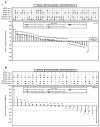Phase 1/1b dose escalation and expansion study of BEZ235, a dual PI3K/mTOR inhibitor, in patients with advanced solid tumors including patients with advanced breast cancer
- PMID: 29882016
- PMCID: PMC6286256
- DOI: 10.1007/s00280-018-3610-z
Phase 1/1b dose escalation and expansion study of BEZ235, a dual PI3K/mTOR inhibitor, in patients with advanced solid tumors including patients with advanced breast cancer
Abstract
Purpose: To determine the maximum tolerated dose (MTD) of BEZ235, an oral inhibitor of class I PI3K and mTOR complexes 1 and 2.
Methods: We performed a phase I/Ib, multicenter, open-label study of oral BEZ235 administered in a continuous daily schedule. The study consisted of two parts: dose-escalation part and safety-expansion part. BEZ235 was administered as a single agent to patients with solid tumors or in combination with trastuzumab for HER2+ advanced breast cancer (aBC). Primary end points were MTD, safety, and tolerability. The secondary end point was pharmacokinetics. Other formulations of BEZ235, solid dispersion system (SDS) sachet, and SDS capsules were also assessed.
Results: One hundred and eighty-three patients were enrolled; single-agent BEZ235 was administered as hard gelatin capsule (n = 59), SDS capsules A and B (n = 33), and SDS sachet (n = 61), amongst which SDS sachet was chosen as the preferred formulation. The monotherapy MTD for capsule A and SDS sachet was determined to be 1000 and 1200 mg/day, respectively. Thirty patients with HER2+ aBC received BEZ235 in combination with trastuzumab. The MTD of BEZ235 in combination with trastuzumab was 600 mg/day. A total of four patients (13.3%) achieved partial response across the different groups. Most frequent AEs in single agent and combination cohorts included nausea (80.3 and 93.3%), diarrhea (75.4 and 80.0%), and vomiting (63.9 and 63.3%).
Conclusions: The MTD of BEZ235 as single agent was 1200 and 600 mg/day with trastuzumab. Pharmacokinetic profiles showed low-to-moderate variability at low dose (10 mg) and high variability at high doses (100 mg and above). Gastrointestinal AEs were frequent at high doses.
Keywords: BEZ235; Breast cancer; Inhibitor; PI3K; mTORC1/2.
Figures


Similar articles
-
A phase 1 study of the sachet formulation of the oral dual PI3K/mTOR inhibitor BEZ235 given twice daily (BID) in patients with advanced solid tumors.Invest New Drugs. 2015 Apr;33(2):463-71. doi: 10.1007/s10637-015-0218-6. Epub 2015 Feb 25. Invest New Drugs. 2015. PMID: 25707361 Clinical Trial.
-
A Phase Ib Study of the Dual PI3K/mTOR Inhibitor Dactolisib (BEZ235) Combined with Everolimus in Patients with Advanced Solid Malignancies.Target Oncol. 2017 Jun;12(3):323-332. doi: 10.1007/s11523-017-0482-9. Target Oncol. 2017. PMID: 28357727 Free PMC article. Clinical Trial.
-
A phase I study of single-agent BEZ235 special delivery system sachet in Japanese patients with advanced solid tumors.Cancer Chemother Pharmacol. 2019 Feb;83(2):289-299. doi: 10.1007/s00280-018-3725-2. Epub 2018 Nov 16. Cancer Chemother Pharmacol. 2019. PMID: 30446785 Free PMC article. Clinical Trial.
-
[Current development status and prospect of dual PI3K/mTOR inhibitors for cancer therapy].Nihon Yakurigaku Zasshi. 2013 Oct;142(4):156-61. doi: 10.1254/fpj.142.156. Nihon Yakurigaku Zasshi. 2013. PMID: 24107518 Review. Japanese. No abstract available.
-
Drug evaluation: the thioredoxin inhibitor PX-12 in the treatment of cancer.Curr Opin Investig Drugs. 2006 Dec;7(12):1108-15. Curr Opin Investig Drugs. 2006. PMID: 17209529 Review.
Cited by
-
Genomic signature of MTOR could be an immunogenicity marker in human colorectal cancer.BMC Cancer. 2022 Jul 26;22(1):818. doi: 10.1186/s12885-022-09901-w. BMC Cancer. 2022. PMID: 35883111 Free PMC article.
-
Is There a Role for Dual PI3K/mTOR Inhibitors for Patients Affected with Lymphoma?Int J Mol Sci. 2020 Feb 5;21(3):1060. doi: 10.3390/ijms21031060. Int J Mol Sci. 2020. PMID: 32033478 Free PMC article. Review.
-
Targeting mTOR and Glycolysis in HER2-Positive Breast Cancer.Cancers (Basel). 2021 Jun 11;13(12):2922. doi: 10.3390/cancers13122922. Cancers (Basel). 2021. PMID: 34208071 Free PMC article. Review.
-
Cardiac Safety of Kinase Inhibitors - Improving Understanding and Prediction of Liabilities in Drug Discovery Using Human Stem Cell-Derived Models.Front Cardiovasc Med. 2021 Jun 16;8:639824. doi: 10.3389/fcvm.2021.639824. eCollection 2021. Front Cardiovasc Med. 2021. PMID: 34222360 Free PMC article.
-
Metabolic Interventions in Tumor Immunity: Focus on Dual Pathway Inhibitors.Cancers (Basel). 2023 Mar 29;15(7):2043. doi: 10.3390/cancers15072043. Cancers (Basel). 2023. PMID: 37046703 Free PMC article. Review.
References
-
- Brachmann S, Fritsch C, Maira SM, Garcia-Echeverria C. PI3K and mTOR inhibitors: a new generation of targeted anticancer agents. Curr Opin Cell Biol. 2009;21:194–198. - PubMed
-
- Burris HA., III Overcoming acquired resistance to anticancer therapy: focus on the PI3K/AKT/mTOR pathway. Cancer Chemother Pharmacol. 2013;71:829–842. - PubMed
-
- Huang WC, Hung MC. Induction of Akt activity by chemotherapy confers acquired resistance. J Formos Med Assoc. 2009;108:180–194. - PubMed
Publication types
MeSH terms
Substances
Grants and funding
LinkOut - more resources
Full Text Sources
Other Literature Sources
Medical
Research Materials
Miscellaneous

